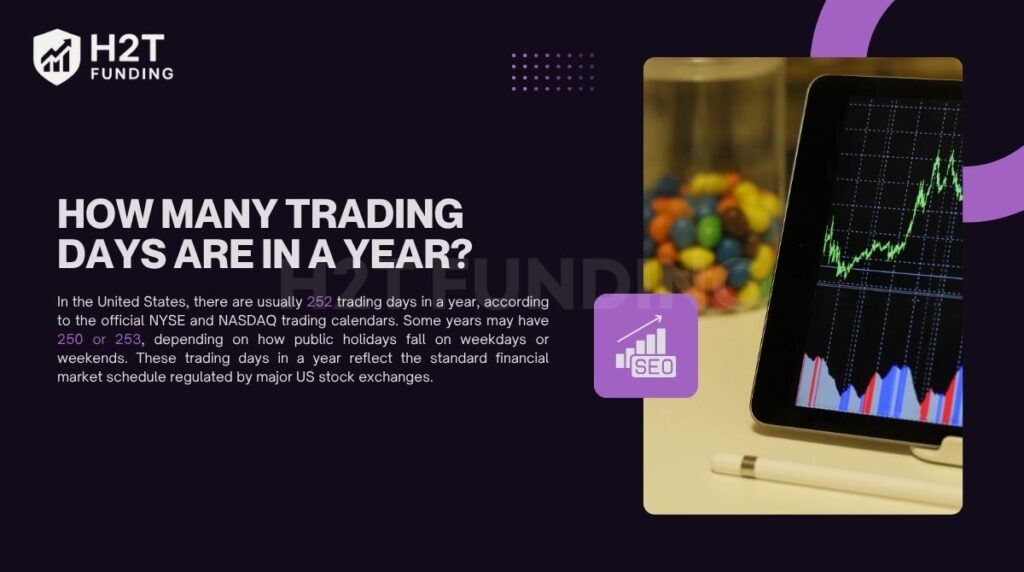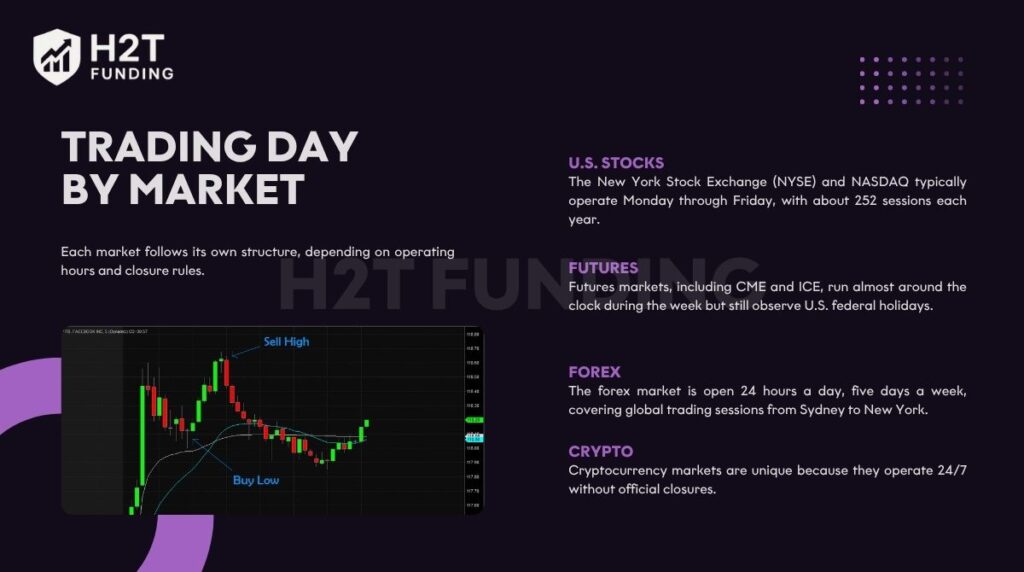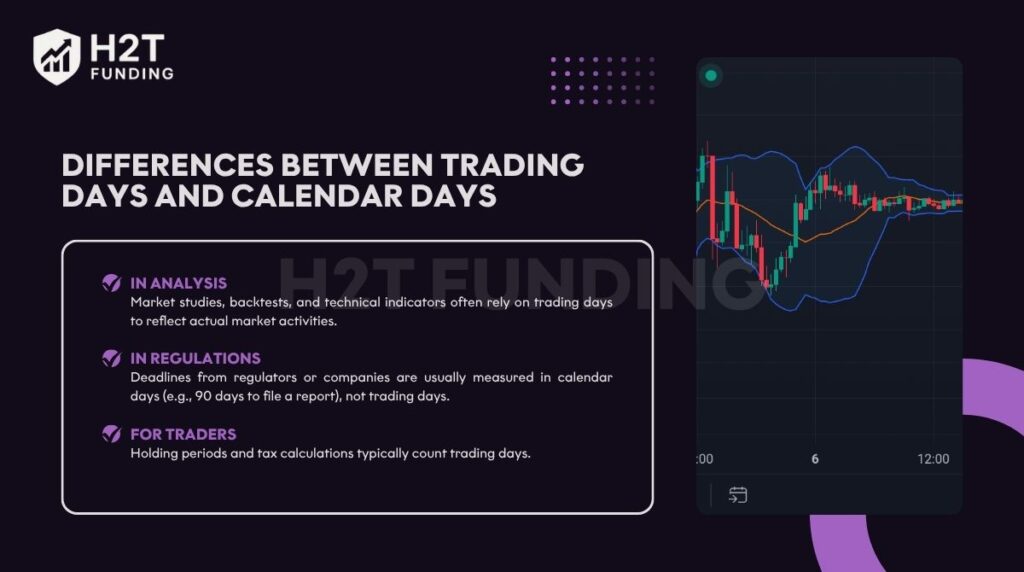For traders planning strategies or backtesting, one of the most common questions is, How many trading days are in a year? The quick answer: in the U.S. stock market, there are usually 252 trading days.
This number excludes weekends and official public holidays when stock exchanges remain closed. Understanding this figure helps traders align profit targets, manage risk, and plan more realistic trading strategies, a principle that H2T Funding emphasizes in every trading education guide.
Key takeaways:
- A typical year has about 252 trading days on U.S. stock exchanges.
- Weekends and public holidays reduce the number from the full 365 calendar days.
- Forex markets operate 24 hours a day, five days a week, while crypto runs 24/7.
- Knowing the exact number of trading days in a year improves backtesting accuracy and annual planning.
- In 2025, U.S. markets follow an official trading calendar with specific closures and half-days.
1. What is a trading day?
A trading day is any business day when financial markets are open for buying and selling securities. For traders who want to understand how these sessions operate around the world, see our full guide on the 4 trading sessions.
On these days, market activities such as placing orders, matching trades, and setting prices occur during official trading hours or extended trading hours on some exchanges.

Unlike calendar days, trading days exclude weekends and public holidays, when markets such as the US stock exchanges (NYSE, NASDAQ) remain closed. That is why the number of trading days in a year is always smaller than 365.
Difference between trading days and calendar days:
| Term | Definition | Example |
|---|---|---|
| Calendar Day | Any day in the year, including weekends and holidays. | 1 January, 25 December, Sunday, Saturday. |
| Trading Day | A day when exchanges are open and market activities take place. | Monday–Friday, excluding New Year’s Day or Independence Day. |
For a trader, confusing these two concepts can lead to costly mistakes. Imagine you build your annual profit plan based on 365 days; your projections could be seriously skewed. Using the wrong trading calendar will invalidate your backtesting results, as it doesn’t reflect the actual market activities that took place.
2. How many trading days are in a year?
In the United States, there are usually 252 trading days in a year, according to the official NYSE and NASDAQ trading calendars. Some years may have 250 or 253, depending on how public holidays fall on weekdays or weekends. These trading days in a year reflect the standard financial market schedule regulated by major US stock exchanges.

A trading year has about 252 days, calculated by subtracting weekends and holidays from 365 calendar days. If you’re planning to analyze or test your performance across these trading days in a year, you can follow our complete tutorial on how to backtest a trading strategy to ensure accurate results. These are the key closures that reduce the number of trading days in a year:
- New Year’s Day (Jan 1)
- Martin Luther King Jr. Day (third Monday in January)
- Presidents’ Day (third Monday in February)
- Good Friday (March/April, varies by year)
- Memorial Day (last Monday in May)
- Juneteenth National Independence Day (June 19)
- Independence Day (July 4)
- Labor Day (first Monday in September)
- Thanksgiving Day (fourth Thursday in November)
- Christmas Day (December 25)
On some occasions, there are half-trading days, such as the day after Thanksgiving or Christmas Eve. These shorten market activities but still count as official trading days in the year.
3. How many trading weeks in a year?
There are about 50 trading weeks in a year. A calendar year has 52 weeks, each with 5 weekdays, which creates a maximum of 260 possible trading sessions. But since U.S. exchanges close for around 9–10 market holidays, the real total falls to about 251 or 252 sessions.

If we divide those sessions by five, the result is close to 50 full weeks of active trading. This means traders can generally count on 50 weeks of market opportunities, even though exact figures shift slightly depending on the year.
For example, when checking how many trading days per year exist, the difference between 250 and 252 still rounds to roughly 50 weeks. This benchmark helps traders plan strategies, manage annual goals, and align backtesting results more realistically.
4. Factors affecting the number of trading days
The number of trading days in a year is not fixed at 365; it changes depending on several elements. While weekends remove a predictable portion, other factors such as public holidays, special events, or even leap years also shape the final count. Understanding these helps traders build realistic schedules and avoid planning mistakes.

4.1. Market holidays
Every stock exchange observes a set of official holidays when trading is closed. For U.S. markets, this usually includes New Year’s Day, Independence Day, Thanksgiving, and Christmas. These closures reduce the yearly total by about 9–10 days.
4.2. Weekends
Most global exchanges are closed on Saturdays and Sundays, automatically cutting 104 calendar days from the trading schedule. This makes weekends the single largest factor in reducing available sessions.
4.3. Major events or emergencies
Unplanned events such as natural disasters, political crises, or state funerals can lead to unexpected closures. For example, U.S. markets shut down for several days during Hurricane Sandy in 2012 and paused for a day in 2018 for the funeral of President George H.W. Bush.
4.4. Leap years
A leap year adds one extra day to the calendar. If February 29 falls on a weekday and does not coincide with a holiday, it can add one additional trading session. However, this happens rarely.
4.5. Trading hours and extensions
Core market hours (e.g., 9:30 AM to 4:00 PM ET for the NYSE) define a trading day. Pre-market and after-hours sessions extend opportunities but do not change the official daily count.
By accounting for these factors, traders can better align strategies, manage time, and adjust expectations for the year ahead.
5. Trading day by market
The count of trading days is not the same across all asset classes. Each market follows its own structure, depending on operating hours and closure rules. Knowing these differences helps traders choose the right instruments and plan effectively.

5.1. U.S. stocks (NYSE, NASDAQ)
The New York Stock Exchange (NYSE) and NASDAQ typically operate Monday through Friday, with about 252 sessions each year. Closures happen on major U.S. holidays such as Independence Day or Thanksgiving, and occasionally, there are half-days.
5.2. Futures
Futures markets, including CME and ICE, run almost around the clock during the week but still observe U.S. federal holidays. Although their sessions are longer than the stock markets, the total number of full trading days aligns closely with equities.
5.3. Forex (24/5)
The forex market is open 24 hours a day, five days a week, covering global trading sessions from Sydney to New York. To trade efficiently in this high-liquidity environment, understanding position sizing is key; see our full guide on how to calculate lot size in forex.
This creates continuous liquidity from Monday morning in Sydney until Friday evening in New York. Even though it spans multiple time zones, the effective structure is still 5 trading days per week.
5.4. Crypto (24/7)
Cryptocurrency markets are unique because they operate 24/7 without official closures. There are no weekends or public holidays, meaning traders can act every day of the year. For those seeking to turn this constant trading opportunity into a sustainable income, our detailed guide on can you make a living as a day trader explains the skills and discipline required. However, liquidity may drop during weekends compared to weekdays.
When people ask how many trading days in a year, the answer depends on the financial market. U.S. stock exchanges average about 252 trading days, the forex market operates around 260 sessions, and crypto markets run 365 days a year.
To provide a clearer perspective, here’s a comparison of trading days in different global markets:
| Exchange | Region | Average Trading Days per Year | Notes |
|---|---|---|---|
| NYSE / NASDAQ | USA | ~252 | Closes for 9–10 public holidays |
| LSE | UK | ~253 | Closed on bank holidays |
| TSE | Japan | ~244 | Affected by Golden Week |
| HKEX | Hong Kong | ~249 | Closed during Lunar New Year |
| NSE | India | ~246 | Includes regional market closures |
6. 2025 trading day calendar (US)
The NYSE and NASDAQ trading calendar for 2025 includes approximately 252 trading days in a year, influenced by weekends, market holidays, and half-day trading sessions. Below is a simplified table showing the key market closures for 2025, based on data from the NYSE official calendar:
| Month | Full Closures | Half-Day Sessions |
|---|---|---|
| January | Jan 1 (New Year’s Day), Jan 20 (MLK Jr.) | – |
| February | Feb 17 (Presidents’ Day) | – |
| April | Apr 18 (Good Friday) | – |
| May | May 26 (Memorial Day) | – |
| June | Jun 19 (Juneteenth National Independence Day) | – |
| July | Jul 4 (Independence Day) | Jul 3 (Half-Day) |
| September | Sep 1 (Labor Day) | – |
| November | Nov 27 (Thanksgiving Day) | Nov 28 (Half-Day) |
| December | Dec 25 (Christmas Day) | Dec 24 (Half-Day) |
For a complete overview, you can review or download the official document here: NYSE 2025 Yearly Trading Calendar (PDF). This calendar lists every closure date, early close, and key trading milestone, such as quarterly options expirations.
Keeping this calendar helps you calculate trading days accurately and avoid strategy disruptions.
7. Differences between trading days and calendar days
At first glance, trading days and calendar days may look the same, but for traders, the difference is crucial. A calendar day counts every day in the year, weekends, holidays, and weekdays alike. By contrast, a trading day refers only to sessions when markets are open for business, typically Monday through Friday, excluding official holidays.

Why does this distinction matter?
- In analysis: Market studies, backtests, and technical indicators often rely on trading days to reflect actual market activities. For traders learning how to read market structures, check out our detailed guide on what support and resistance are to better understand how the price reacts during active trading sessions. Using calendar days instead could distort moving averages or trend patterns.
- In regulations: Deadlines from regulators or companies are usually measured in calendar days (e.g., 90 days to file a report), not trading days.
- For traders: Holding periods and tax calculations typically count trading days. For example, buying a stock on Friday and selling it on Monday spans three calendar days but only one trading day.
Mixing up these two concepts can lead to costly errors. If you assume 365 sessions when asking how many trading days are in a year, your profit projections may be inflated by nearly 30%. That’s why most professionals stick to trading-day counts when modeling returns or setting annual goals.
8. Why is the number of trading days important to traders?
So, why is knowing how many trading days per year so critical? The answer is simple: it’s the foundation of every effective trading plan in the financial market.
When you overlook market holidays or weekends, you aren’t just miscalculating; you’re setting unrealistic expectations for your trading strategies, which ultimately leads to flawed analysis.
8.1. Impact on backtesting
Backtesting depends on accurate data. To effectively track and analyze this data over time, maintaining a detailed record is essential. See our complete guide on what a trading journal is to learn how consistent documentation improves your trading strategies.
Using calendar days instead of business days skews results, leading to unrealistic performance metrics. For instance, strategies tested on 365 sessions may look more profitable than they actually are when applied to real US stock exchange schedules.
8.2. Planning annual profits
Traders often set yearly profit targets based on expected returns per day or per week. For example, if a trader plans for 1% profit per day but mistakenly assumes 365 trading days per year instead of the actual 252 trading days, their expected annual gain would be over 44% higher than reality.
Aligning with the official trading calendar of US stock exchanges ensures more realistic goals and accurate backtesting results across roughly 50 trading weeks per year.
8.3. Managing time and expectations
The number of trading sessions also influences time management. Day traders use every active session, while swing traders may focus on high-liquidity periods such as the Sydney session or New York session. Factoring in extended trading hours or temporary market closures helps traders seize the right trading opportunities without overextending.
Knowing the exact trading days helps build realistic strategies and manage expectations.
9. Notes when planning transactions based on the number of trading days
When building a trading plan, the exact number of business days available in a year can make or break your strategy. Ignoring weekends, public holidays, or sudden market closures often leads to missed trades and skewed results. Below are key considerations for traders aiming to stay aligned with the real trading calendar.
9.1. Impact of special events on trading schedules
Unexpected events such as natural disasters, political crises, or global health emergencies can disrupt market activities. For example, U.S. exchanges have closed in the past due to hurricanes or national mourning periods. In the forex market, trading continues 24/5, but volatility may spike during uncertain times. These disruptions can temporarily reduce trading opportunities or create abnormal price swings.
9.2. Tips to avoid missing important trading days
- Track official calendars: Always download the annual schedule from US stock exchanges or other venues you trade. This prevents surprises on holidays like Thanksgiving or Christmas.
- Leverage technology: Use alerts or sync the trading sessions of your chosen markets (e.g., the Sydney session or New York session) with your personal calendar.
- Plan for liquidity shifts: On half-days or around holidays, liquidity tends to thin out. Adjust your trading strategies accordingly to smaller positions, tighter stops, or waiting for normal trading hours.
- Build in flexibility: Leave room in your plan for unplanned market closures or reduced volatility weeks. This ensures realistic expectations across the 50 or so trading weeks each year.
By respecting these notes, traders align their actions with the real-world dynamics of the financial market and make better use of limited sessions.
10. FAQs
On average, there are 20 to 21 trading days per month, depending on weekends and market holidays. Months with more federal holidays, like December, usually have fewer sessions.
For US stock exchanges such as the NYSE and NASDAQ, the official trading hours run from 9:30 AM to 4:00 PM ET, totaling 6.5 hours. With extended trading hours (pre-market and after-hours), activity can stretch from 4:00 AM to 8:00 PM ET.
No. Each exchange follows its own trading calendar. For example, the Tokyo Stock Exchange averages around 240 sessions, while the Hong Kong Exchange has about 249. Variations come from national holidays and different trading sessions.
According to the official NYSE calendar, U.S. markets will have roughly 252 trading days in 2025, excluding weekends and official closures.
The total depends on how holidays fall on the calendar. If a holiday lands on a weekday, one less trading day is counted. Leap years can also shift totals slightly.
Typically, there are 250 to 252 stock trading days in a year for U.S. markets. This number adjusts for market holidays and weekends.
No. While 252 is common, the count can range from 250 to 253 depending on how weekends and holidays align in a given year.
It’s a trading guideline suggesting that the first 30 minutes after the market opens often show false signals. Many traders wait until around 10:00 AM ET to confirm trends before entering positions.
Two hundred trading days is roughly 10 months of market activity, since each month averages 20 sessions. Analysts often use the 200-day moving average to gauge long-term trends.
No, but it carries risks. Day trading involves skill, strategy, and risk management within the financial market. Unlike gambling, success depends on discipline, research, and timing.
Trading 212, a retail trading platform, was founded in 2004. It has since grown into a widely used broker offering access to stocks, ETFs, and forex.
11. Conclusion
Understanding how many trading days are in a year is essential for traders who want accurate backtests, realistic profit goals, and effective time management. With U.S. markets averaging around 252 sessions annually, aligning strategies to the official trading calendar ensures you avoid false assumptions and missed opportunities.
At H2T Funding, we not only break down market structures but also help traders sharpen their skills across categories like Prop Firm & Trading Strategies. By combining solid knowledge of trading schedules with disciplined execution, you can transform theory into consistent results.





